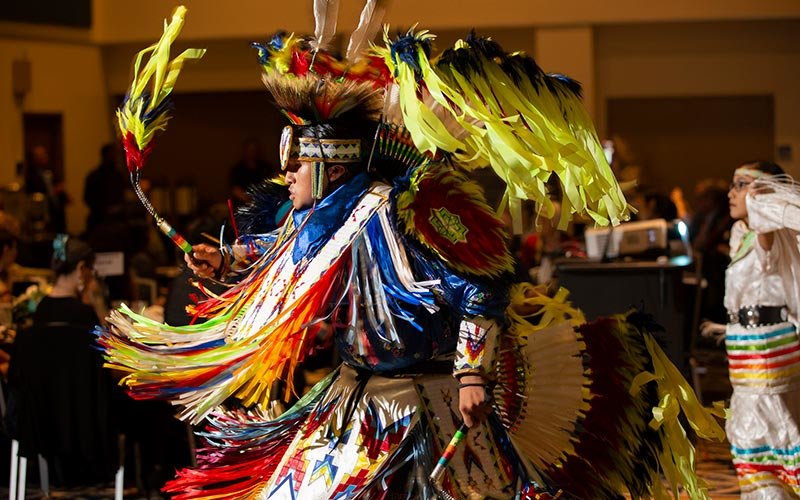
Cal State Fullerton recognized and celebrated the diversity of its Native American students, faculty and staff last night with native prayer and blessing, songs and dancing. This led up to a presentation by keynote speaker Eric Tippeconnic, a member of the Comanche Nation of Oklahoma, an artist and lecturer in history on campus.
“I have a deep and profound feeling for the region’s true first families,” said President Fram Virjee to the approximately 100 guests. “These tribes lived prosperously and peacefully on this very land for more than 10,000 years.
“I am pleased that CSUF honors this history, along with the history of all the indigenous peoples of our region, in a variety of ways, and not just one month out of the year,” he explained. “As a foundation of this work, the Inter-Tribal Student Council has been assisting Native American/indigenous students achieve their academic dreams and life goals since the early 1960s.
“In 2017, Associated Students Inc. passed a resolution supporting and recognizing Indigenous People’s Day and last year, we hosted the first Native American Heritage Month President’s Reception in our university’s history.
“Make no mistake, these are important actions by our university,” he added. “That said, we can and must do better; we can and must do more; we can and must reach higher.”
Family Background Reflects a Nation’s History
The audience was quickly entranced by the words of Tippeconnic as he told the story of his family, including the “around the world” romance of his father, a full-blooded Comanche serving in the U.S. Navy, who met and fell in love with a 17-year-old girl in Copenhagen.
Tippeconnic, the first in his tribe to earn a doctorate, shared the culture and history of his people, including how the Comanche became incredible horsemen and the symbolism in the Comanche Nation’s flag, which includes a horseman.
“History was always important to me,” he noted, remembering how he grew up among different tribal cultures and spent summers, first with his father’s family and the next year with his mother’s.
“After the 1874-75 Red River War, the Comanche food supply was cut off and opportunities for social advancement disappeared,” he noted. In an effort to “count coup” or gain prestige, five men “went to Fort Sill (Oklahoma) and stole 350 head of horses that they then sold in Texas.”
Showing a photograph of the five men, Tippeconnic pointed out one man, the leader of the action. As part of the effort to “count coup,” he gave away the money to the other four men and then returned to the fort, where he was imprisoned.
Tippeconnic explained that individuals got their names through recognition of their actions. For the man who led the effort to steal the horses, the tribe named him Tupi-Kuni, or Rock House, the name they had for the jail. It would later become Anglicized to Tippeconnic.
“He was my great grandfather and that’s how we got our name,” Tippeconnic said. When his grandfather went to boarding school, he became the first to carry both a first and a last name: John Tippeconnic.
“Instead of the horse, my grandfather used education. He was the first in his tribe to get a college degree — in 1926, when the majority of Americans didn’t have even a high school diploma.
“Then he went to graduate school and became the first indigenous member of any tribe to get a master’s degree in the 1940s. He used education to rise up and then helped his people.
“Through stories and my art, I can share history and begin conversations,” said Tippeconnic.